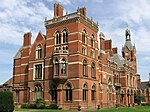Averham
Civil parishes in NottinghamshireEngvarB from May 2016Newark and SherwoodOpenDomesdayVillages in Nottinghamshire

Averham is a village and civil parish in the Newark and Sherwood district of Nottinghamshire, England. According to the 2001 census it had a population of 187, increasing to 294 at the 2011 census (which included Staythorpe), however Averham alone reported 215 residents at the 2021 census. The village is just west of Newark-on-Trent. Staythorpe Power Station is south-west of the village.
Excerpt from the Wikipedia article Averham (License: CC BY-SA 3.0, Authors, Images).Averham
Ayrshire Way, Newark and Sherwood
Geographical coordinates (GPS) Address Nearby Places Show on map
Geographical coordinates (GPS)
| Latitude | Longitude |
|---|---|
| N 53.08 ° | E -0.86 ° |
Address
Ayrshire Way
Ayrshire Way
NG23 5FW Newark and Sherwood
England, United Kingdom
Open on Google Maps






